How to properly mount the sink to the wall: step-by-step instruction
A sink is an essential element for any bathroom. On sale you can find many different models that differ in the material of manufacture, shape and installation method.
Among the entire assortment, sinks mounted to the wall are in great demand. Such plumbing helps out in a limited space of a bathroom or bath, and its installation does not cause any special difficulties. Fasten the sink to the wall on your own. Doubt your own strength?
We will tell you how to choose the optimal model and dimensions of plumbing, what tools will be needed during the work, and also we will give installation instructions with a description of each technological stage.
The content of the article:
How to determine the size of the sink?
All plumbing fixtures can be divided into several groups, differing in size:
- compact mini sinksspecially designed for small rooms;
- standard equipment - provided in the product lines of most manufacturers;
- combined devicescombining two or more shells;
- non-standard equipment the most various sizes and forms - it is carried out according to individual projects.
When placing plumbing equipment in a room, three of its main parameters must be taken into account: depth, width and height. This is the only way to choose the device of optimal size for a particular room.
This is very important, because an oversized sink will take up a lot of free space, and a small one will be inconvenient to use. Not only the width is important, but also the depth of the product.

For the correct choice of the width of the sink, you need to remember that 0.5-0.65 m is considered the best option.Such equipment fits well into a medium-sized room and does not "eat" free space in it. It is convenient for washing and does not spray water on the floor.
Such a sink will look good in a large room, but wider models that solve some special design tasks are appropriate here.
The minimum width of sinks sold in stores is only 0.3 m. They are certainly not convenient enough to use, but there are no other options for small rooms.
When choosing a plumbing fixture, you need to evaluate the installation method of the mixer. Most often, it crashes into the middle of the so-called installation site, where a special hole is provided for these purposes. Installation site dimensions are also important.
If you plan to install a double sink, and this is very appropriate in large families, you need to choose models where the distance between the centers of the two devices exceeds 0.9 m. Otherwise, using such equipment will be very inconvenient.
The distance to the wall also matters. Practice shows that the best option is 0.48-0.6 m. In this case, you need to focus on the arm length of the person who will use the device.
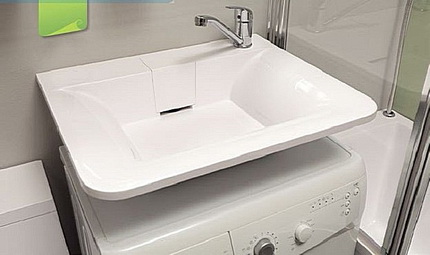
It is easy to do. You need to stand near the sink and extend your arm, its opposite edge should be at the fingertips or in the middle of the palm of the hand. Using such equipment will be convenient.
Pay attention to the depth of the bowl. The larger it is, the less likely it is to spray the water falling into it. The best in this regard are models of the type "tulip" or "half-tulip." They are quite deep. Worst of all are the flat “water lilies” that are placed above the washing machines and some overhead sinks.
And the last important nuance: device installation height. She is selected based on the growth of living in the house. It is advisable that everyone is comfortable using the equipment. On average, the installation height is 0.8-0.85 m.
Cantilever models can be hung to the desired height, while appliances with a pedestal set to the height specified by the manufacturer.
All sinks are divided into two large groups: mounted on a wall or on a base. The second option assumes the presence of a pedestal, on which the bowl rests.
When fixing the sink to the wall, all of its mass falls on the mounts or on a special frame. Therefore, they need to be fixed especially carefully. Such models are extremely undesirable to mount on partitions. A solid supporting wall should be chosen as the base; otherwise, the structure may simply fall to the floor.
Cantilever sinks are distinguished by the fact that the engineering communications brought to them remain in sight. This is not aesthetically pleasing, so they try to hide them behind any decorative element.
Alternatively, you can install beautiful details, for example, chrome, which will decorate the interior of the room.

A practical variety of sinks with wall mounts are “tulips”. Their bowl is fixed to the wall. However, part of the weight of the shell takes over the base, which is also called the pedestal.
A big plus of such equipment is a hidden liner of utilities. Pipes are laid inside the pedestal. The design drawback is the inability to adjust the height of the bowl.
For those for whom this is important, you can buy the so-called "half-tulip". This modification assumes that the pedestal does not rest on the floor. He, like the bowl, is attached to the wall. This base is shorter than the pedestal of a standard sink. But the eyeliner pipes still hide inside the base.
We carry out preparatory work
Before starting the installation of the sink, you must accurately determine the place where it will be located, and with the procedure for connecting equipment to utilities. Once again, carefully measure the height of the device and its width.
When choosing the installation location, be sure to take into account that the approach to the sink should be free. In addition, it should be convenient to use.
If the plumbing fixture will be installed in place of the old device, the latter will need to be dismantled. This must be done very carefully and carefully so as not to damage the old sewer and water pipes.
After dismantling, we carefully clean the place of the future installation, prepare the sections for connecting engineering communications. Experts recommend avoiding the use of all kinds of adapters whenever possible. They degrade the sealing of joints and spoil the appearance of the structure.
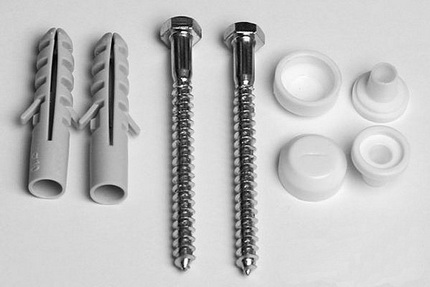
In some cases, adapters cannot be dispensed with. For example, if you have to equip a connection with very old pipes. Then it is advisable to purchase quality parts that are most suitable for the pipeline.
Another point. It is important to properly equip the sink if it is sold without a siphon and other elements. It should be understood that the siphon does not apply to universal elements. Different siphons are designed for different models of equipment. For example, one that is suitable for a steel product is not suitable for sanitary ware.
Usually a conscientious manufacturer completes the sink with everything necessary. If so, you should make sure that all the parts are in place. It is advisable to immediately purchase and suitable mixer.
Detailed installation instructions
We start by preparing the tools.
For work you will need:
- gas key;
- screwdriver;
- wrenches;
- drill with a drill equipped with a victorious tip;
- hammer;
- construction level;
- marker or pencil.
In addition, you need to prepare plumbing sealant, sealant type tape Fum and fasteners. On sale you can find special sets of fasteners for the sink. If you purchase such a kit from a trusted manufacturer, this will be the best option.
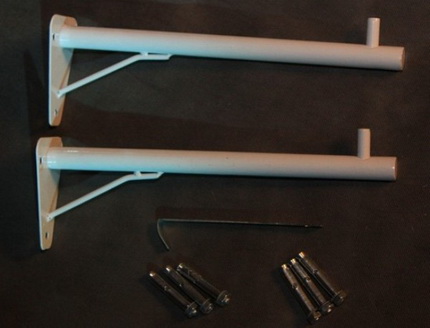
After the tools and materials are prepared, turn off the water, both hot and cold. You can get to work.
We outline the place of attachment of the sink
We start with the markup. The first thing to note on the wall is the central horizontal. It will become the upper limit along which the edge of the sanitary equipment will be exposed. Using the level, check the horizontal. Short vertical lines mark the width of the bowl.
Next, measure the thickness of the side walls of the sink and set this value down from the central horizontal.
We connect both marks with a line that will show the mounting height of the brackets. After that, take the sink and turn it over. Then we fix the brackets on the side walls. After that, apply the bowl to the upper horizontal mark, press it against the wall.
At the same time, we make sure that all previously outlined lines coincide. We insert the marker into the hole, mark the places for mounting fixtures.
Install brackets
We take a drill with a drill and in the designated places we prepare holes for fasteners. Their depth should slightly exceed the length of the dowels, and the diameter should be slightly less than the cross section of the bushings. A little glue can be put inside the holes so that the plugs hold better.
Using a hammer, hammer dowels into the holes. Then we take fasteners and we turn them into the plastic base one by one.
We mount brackets for the sink
We install brackets on the prepared fasteners, which are supports for the bowl. We put a sink on them and, holding it with your hand, mark with a marker the places where fasteners will be installed that fix the device to the wall.
We remove the bowl and prepare the holes for the fasteners. We hammer in their liners and screw fasteners.
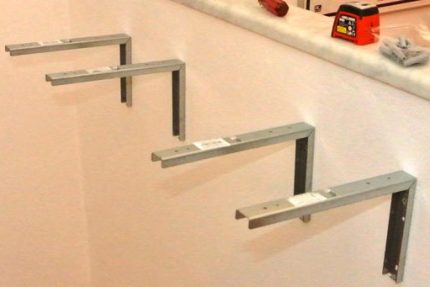
Before installation, apply sealant to the edge of the bowl so that water does not leak into the gap between the wall and the sink. Alternatively, you can use a special plastic strap that will provide maximum protection against water. Glue it on silicone sealant. We put the sink in place, but until finally we do not fix it.
We put and connect the mixer
You need to know that the mixer can be mounted on the installation site before the sink is put in place, or after that. Everyone does what is convenient for him. In any case, you need to remember that special materials will be needed to install the mixer.
Typically, the manufacturer complements them with their products. If this is not the case, you will need to purchase studs, nuts, washers, and gaskets.
Before installing the mixer, it is advisable to carefully read the manufacturer's instructions and strictly follow its recommendations. Typically, such instructions describe the installation process in detail, taking into account all the features of a particular model.
First, the mixer must be assembled in a single unit. In this case, tabs and seals are necessarily used. Before assembly, the o-ring is usually worn on the spout.
The nuts from the studs must be removed, and then put the mixer in place. Previously, a sealing ring is placed under the device and connecting hoses are pulled into the hole on the mounting plate.
The equipment is fixed to the sink with a clamping nut. This is done very carefully so as not to overtighten the nut, otherwise the sink may crack.

If the pipe couplings and mixer inlet axes do not meet, the connection is made using special eccentric adapters. They have different thread diameters at opposite ends. The clamping nut is first twisted manually, then with a key half a turn. Most often, this is enough.
After the mixer is fixed in place, you can connect it to the water supply. Most often, flexible eyeliners are used for these purposes. We connect them to the pipes. We bring hot water to the left hose, and cold water to the right.
First, tighten the nuts manually, then tighten with an adjustable wrench. To seal the joint, be sure to use Fum tape or similar material.Winding is performed along the thread.
An important nuance: the length of the flexible hoses. It should not be too big, otherwise they will not sag ugly. Also, it cannot be too small, otherwise the hose will be pulled, which will cause it to fail prematurely. In addition, the hoses must lie flat, without kinking or bending.
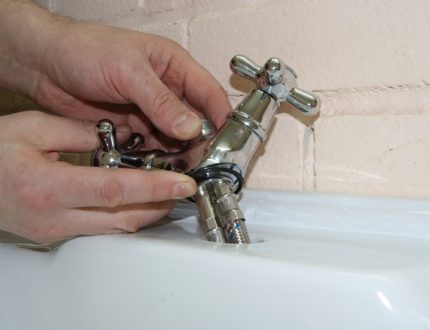
After completion of work, it is necessary to check the quality of the connections. This must be done after the siphon is connected, since you have to supply water to the mixer.
During the check, the possible presence of water at the flexible connections and near the mixer is carefully monitored. If so, then tighten the nuts slightly with a wrench.
Detailed installation instructions for the mixer are described in this article.
We connect the siphon to the sewer
On sale you can find different siphon models, when installing each of them, nuances are possible, so you should carefully study the installation instructions from the manufacturer. Consider the simplest option with a universal corrugated siphon.
First, we disassemble the siphon and check it for gaskets, thread strength and the absence of debris inside the assembly. During the installation process, it is desirable to moderately lubricate the threads and gaskets with sealant, so leakage protection will be even more reliable.
We press the siphon with a special thick pad with one hand to the drain. It is necessary to do this so that the gasket without displacements and gaps fits snugly around the drain around its entire perimeter. With the other hand, we insert the mesh, screw and gasket into the drain hole.
Carefully “bait” the screw, then hold it out. We fix the corrugation. To do this, insert it into the drain socket of the siphon and carefully tighten it with the wing nut.

We connect the siphon to the sewer pipe. To do this, we insert a special rubber sealant inside the pipe, we install a bell of corrugation into it. An important point: the corrugated pipe must lie flat, without bending and twisting. This completes the installation of the siphon.
You can test run the water and check for leaks. If fluid leaks somewhere, repair the defect immediately.
Similarly, a sink without brackets is fixed. The installation process differs in that it is fixed directly to the wall, therefore, during the marking process, the mounting locations are marked, the holes are drilled and the dowels are clogged. Then the sink is applied to the wall and fixed in this place with special fasteners.
“Tulips” and “half-tulips” are fixed in the same way. Their distinguishing feature is the presence of a pedestal on which the bowl fits. It is important to correctly determine the installation height of such a sink, because it must exactly match the height of the pedestal.
After the bowl is installed on the sink mount, a pedestal base is installed under it.
Photo Tulip Sink Installation Guide
Despite the fact that the main load of the sink with the pedestal is distributed on the support leg, the bowl of the plumbing fixture is still attached to the wall:
Installation of a water lily sink
Flat water lilies are designed to be installed above the washing machine. You need to understand that not every model "washing machine" can be installed under the sink. Usually these are compact low devices.
Some companies specifically design and manufacture them. It is optimal that the sink comes complete with such a device. In such a tandem, instruments usually complement each other perfectly.
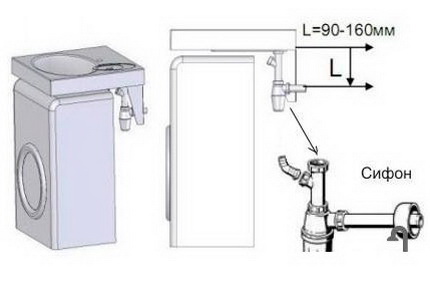
If this is not so, sink “water lily” choose very carefully. It should cover the washing machine at least 10 cm. So the latter will be reliably protected from water splashes. Another important point is the presence of a special drain, which should be located as close as possible to the back or side wall of the device.
There are two varieties of such a drain:
- Round. The flat type siphon is located directly under the drain hole. Water leaves quickly, such a construction is extremely rare. A significant minus is that the siphon is installed above the washing machine, which is fraught with problems with wiring and circuit in the event of an emergency.
- Slit-like. The siphon is fixed to the washing machine in the back wall of the bowl, so if water leaks, water will not get on the electric appliance. However, the drain hole is very narrow and often clogs.
For safety reasons, you can look for a sink with overflow, which will further protect the washing machine from water.

The installation process of "water lilies" is carried out as follows:
- Mark the wall. To do this, draw a horizontal line indicating the upper edge of the device. To make the line strictly horizontal, use the level. We try on the bowl to the drawn line, make sure that there is a sufficient gap between the machine and the sink. If everything is in order, we outline the holes for the fasteners.
- We drill holes, mount fasteners. In this case, we use dowel fasteners or anchor bolts.
- Put the brackets in place. They are fixed in place by bolts. We do not tighten them tightly at first, we leave gaps of about 0.5 cm.
- We process sealant the back of the sink to protect the joint between it and the wall from water. We also apply sealant to the parts of the bracket in contact with the surface of the bowl.
- Put the sink in place. To do this, we put the eyes of the plumbing fixture on metal hooks, after which we fix the device in place with anchors or dowels.
- Checking the reliability of fastening sinks, after which we tighten the bolts that secure the brackets.
At the next stage, a siphon is connected to the sink.This must be done before the brackets are finally tightened.

There are several modifications of siphons for “water lilies”, the procedure for their installation may vary somewhat.
In general terms, the work is performed in the following order:
- We find the assembly instruction and, in accordance with it, collect the siphon. All threaded connections and sealing elements must be coated with silicone. Carefully tighten the thread so as not to break the plastic elements.
- The siphon nozzle, designed to be connected to the washing machine, is put on the drain hose. To make the connection strong, tighten it with a screw clamp. We check its reliability. If it is insufficient, the pressure of the water drained from the machine may break the hose.
- The outlet of the siphon is connected to the sewer pipe. It is advisable to bend the corrugated pipe further and fix it in this position with a soft wire or electrical tape. This will make it possible to eliminate the likelihood of an unpleasant sewer smell, which often happens when installing “water lilies” equipped with a flat siphon.
The design features of the sink do not always allow you to mount the mixer on the bowl. In this case, it is mounted on the wall or on the side of the bathtub to be used alternately with one and the other plumbing fixture.
It is important that the spout length of the device is sufficient for such manipulations. In rare cases, the sink is equipped with a hole for the mixer.
Installation of the mixer is carried out in strict accordance with the manufacturer's instructions after installing the siphon and finally fixing the sink to the brackets. During installation, we pay special attention to high-quality sealing.
All seals must be treated with sealant. Threaded connections are sealed with Fum tape or special plumbing tow and paste.
Nuts on a flexible eyeliner are made of zinc alloys and are quite fragile, so they must be tightened very carefully, otherwise it can be broken. At the end of installation, we carry out a trial run of water. We carefully inspect all the connections, in case of a leak, we immediately fix all the flaws.
Conclusions and useful video on the topic
We offer you to watch useful videos on the topic of the article.
Nuances of proper installation of the sink:
Tips for connecting a siphon wizard:
Mounting and connecting the sink above the washing machine:
Self-installation of the sink is a fairly simple task. Even a novice plumber will cope with it without outside help. It is important to do everything carefully and in strict accordance with the instructions, then the installed sink will last a long time without requiring additional maintenance.
Do you have personal experience fixing a sink to a wall? Want to share your knowledge or ask questions about the topic? Please leave comments and participate in discussions - the feedback form is located below.


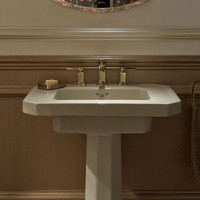 How to install a tulip shell on your own: phased instruction
How to install a tulip shell on your own: phased instruction 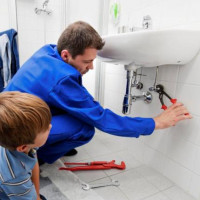 How to fix the bathroom sink to the wall: a detailed instruction on how to fix it
How to fix the bathroom sink to the wall: a detailed instruction on how to fix it  How to collect a sink drain: instructions for installing a drain with overflow
How to collect a sink drain: instructions for installing a drain with overflow 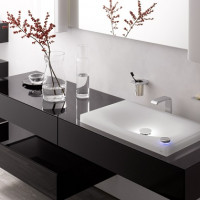 How to determine the dimensions of the sink for the bathroom and not screw up during the repair
How to determine the dimensions of the sink for the bathroom and not screw up during the repair 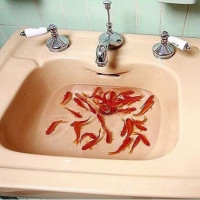 Bottom valve: intended use, device + instruction on replacement
Bottom valve: intended use, device + instruction on replacement  Small washbasins: varieties, photo-selection of options and features of choice
Small washbasins: varieties, photo-selection of options and features of choice  How much does it cost to connect gas to a private house: the price of organizing gas supply
How much does it cost to connect gas to a private house: the price of organizing gas supply  The best washing machines with dryer: model rating and customer tips
The best washing machines with dryer: model rating and customer tips  What is the color temperature of light and the nuances of choosing the temperature of the lamps to suit your needs
What is the color temperature of light and the nuances of choosing the temperature of the lamps to suit your needs  Replacement of a geyser in an apartment: replacement paperwork + basic norms and requirements
Replacement of a geyser in an apartment: replacement paperwork + basic norms and requirements
I would never install a water lily sink directly above the washing machine. When washing, the machine vibrates, sometimes it even bounces from an imbalance of improperly loaded laundry into it. And the sink will also tremble all over time, it will become loose. Why is this necessary? As for the installation of siphons, everything is written in the case. I also advise housewives to put a special grid on the sink both in the bathroom and in the sink. Since women's hair clogs the siphon quickly, and sometimes it’s problematic to clean it (it’s inconvenient to get in there). And when installing, you need to look at the future so that there is room for the convenience of both replacement and cleaning.
I think it’s obvious that water lilies are not set out of great desire, but for reasons of economy of space in a tiny bathroom. As for the vibrations and bouncing of the washing machine, then with a normal installation in terms of level this should not be.
Once you have correctly calculated the places for the screws and drilled holes for them, the rest of the work becomes a trifle. It is the screws that hold the sink, if they are securely fixed, then everything will be in order. A sealant is needed so that water does not flow along the wall. Well, the siphon is all the more easy to connect, you just have to be careful and make sure that all the parts are tightly fitted.